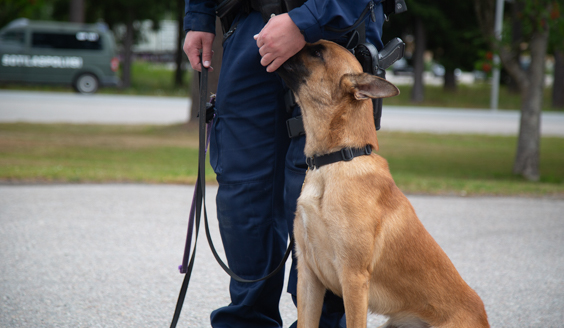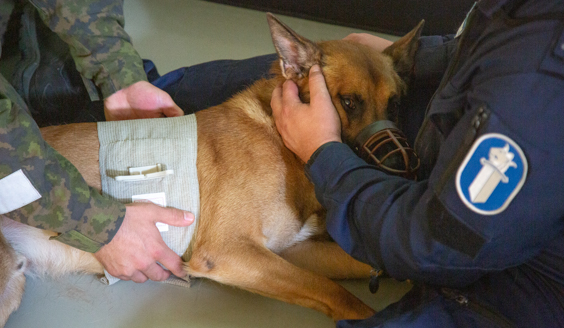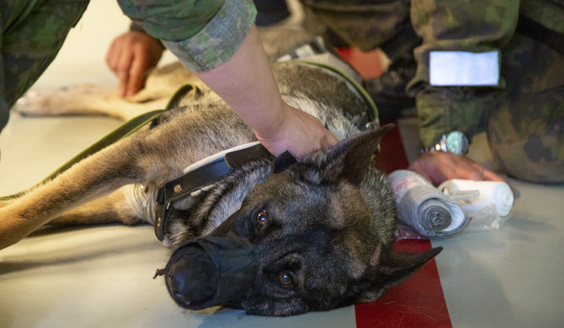Lessons identified for training in military canine combat first aid

At the end of July, a training event with its focus on military working dog first aid took place in Karkialampi, Mikkeli. This training event piloting served in producing guidelines for future development of training in military working dog combat first aid. The training event was attended by service personnel from the Army Command and from the Police.
Providing familiarisation with the most common combat injuries sustained by military working dogs, this training also involved situation assessment practice as well as conducting emergency first aid procedures. As such, the training contents drew from the combat first aid training module revised by the Centre for Military Medicine complemented by international course materials on the topic as applicable.
The training event was led by veterinarian Olli Jokinen who completed the combat first aid instructor course last spring. Now his goal remains to develop combat first aid training relating to military working dog activities.
– Until now, training in military working dog combat first aid has mainly been undertaken on international courses. For the first time this past July, we organised a veterinarian-led training event to determine procedures necessary for developing a training module proper, veterinarian Jokinen explains.
First to respond in case of an incident
The objective in providing training in military working dog combat first aid is to ensure that the military dog handlers identify the most common injuries sustained in combat settings and remain capable of conducting the set first aid procedures. It is often the case that the military dog handler serves as a first responder on site and therefore needs to master the first aid skills. And, when it comes to the crunch, accessing the veterinary medicine aid point may take a lengthy evacuation.
– The key to military working dog survival remains fast first aid. Therefore it is vital that the military dog handler masters the combat first aid skills. Obviously, the military dog handler is the person the canine knows best and thus feels most comfortable with, veterinarian Jokinen points out.
Among the training event participants was Sami Koskiniemi who was content with the training and viewed that plenty of useful knowledge was disseminated.
– This training allowed us to familiarise with both combat first aid skills and everyday incidents. For instance, all dog handlers need the skills for applying basic bandaging as well as recognising the symptoms of a heatstroke.
Koskiniemi works together with a one-year-old Belgian Shepherd-Malinois Sokka, Safety Pin, trained for explosives’ search. As this team of two often is on a mission in forests far from built-up areas, it is necessary to master the first aid skills.
- The missions that we train for tend to be conducted in conditions with no immediate access to a veterinarian. And, as anything can happen, these first aid skills do come in handy. It is good to know how to operate if, for instance, a viper snake bites the dog, not to mention the type of injuries sustained in combat settings. In my opinion, this type of training is useful for each and every military dog handler to undergo.
According to veterinarian Jokinen, this training event piloting served as a beneficial starting point for further training development.
– I hope that, in the future, we have a training module in military canine combat first aid equivalent to that currently available for human beings. There continue to be a lot of requests for these types of training events, veterinarian Jokinen says.
On military working dog activities
- Utilised by the Finnish Defence Forces to support the Military Police in tasks relating to security, the military working dogs are also involved in international tasks.
- Military dog handlers train and supervise the military working dogs to operate in situations involving use of force, search and rescue. Patrol canines are used for area surveillance and target protection missions, whereas rescue canines are trained for the search of explosives, firearms and narcotics.
- While undertaking military service, conscripts can specialise as military dog handlers. During the military service, the dog handlers are assigned set military working dogs. The K-9 usually operates as part of a Military Police platoon. In the Army, military dog handlers are trained in the Kainuu Brigade and in the Pori Brigade.
- The Military Working Dog Unit of the Pori Brigade is the hub of the FDF’s military working dog activities. The Military Working Dog Unit remains responsible for producing military canine services and providing basic training for military dog handlers part of service personnel.






